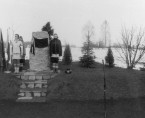- Museum
-
History
- Home Page - History
- Before the extermination
- Auschwitz I
- Auschwitz II-Birkenau
- Auschwitz III-Monowitz
-
Auschwitz sub-camps
- Altdorf
- Althammer
- Babitz
- Birkenau
- Bismarckhütte
- Blechhammer
- Bobrek
- Brünn
- Budy
- Charlottegrube
- Chelmek
- Eintrachthütte
- Freudenthal
- Fürstengrube
- Gleiwitz I
- Gleiwitz II
- Gleiwitz III
- Gleiwitz IV
- Golleschau
- Günthergrube
- Harmense
- Hindenburg
- Hubertshütte
- Janinagrube
- Jawischowitz
- Kobier
- Lagischa
- Laurahütte
- Lichtewerden
- Mesersitz
- Monowitz
- Neu-Dachs
- Neustadt
- Plawy
- Radostowitz
- Raisko
- Sonderkommando Kattowitz
- Sosnowitz (I)
- Sosnowitz (II)
- Sośnica
- SS Bauzug
- SS Hütte Porombka
- Trzebinia
- Tschechowitz (I)
- Tschechowitz (II)
- Auschwitz and Shoah
- Categories of prisoners
- Prisoner classification
- Fate of children
- Life in the camp
- Punishments and executions
- Camp hospitals
- Medical experiments
- Resistance
- Informing the world
- Evacuation
- Liberation
- The number of victims
- The SS garrison
- Holocaust denial
- Auschwitz Calendar
- Photo gallery
- Visiting
-
Education
- Home Page - Education
- Study visits
- Educational projects
- Conferences
- Thematic sessions
- Studies
-
Exhibitions
- Auschwitz, Memory, World
- Forbidden Art
- German Plans for Auschwitz Redevelopment
- June 14, 1940
- Leben? Oder Theatre? Charlotte Salomon 1917-1943
- Nazi German Death Camp Konzentrationslager Auschwitz
- People of Good Will
- Residents of Insurrectionary Warsaw
- So I am here kneeling down upon this Golgotha of modern times...
- The Liberation of KL Auschwitz
- The Memory of Auschwitz
- Traces of them remain
- Women at KL Auschwitz
- Visiting the Memorial
- E-learning
- Library - Online Catalogue
- Volunteer Bureau
- Resources for teachers
- ICEAH – General Information
- “Light of Remembrance”
- Contact
Kobier
The largest of the “forest” sub-camps in the woods between Pszczyna and Tychy, founded in December 1942 within the boundaries of the village of Kobiór (German: Kobier). About 60 prisoners at the start, and later 150, lived in two barracks surrounded by a barbed-wire fence. Most of them were Jews, mainly from Poland, France, Belgium, and Bohemia, along with a few Germans, Poles, and Russians. The largest Kommando worked clearing the forest and performing the on-site processing of the tree trunks. The lumber was turned over to the forestry service and the branches and waste products were used to burn the bodies of the victims of extermination in pits and on pyres in Birkenau.
SS-Unterscharführer Franz Baumgartner held the post of director (Lagerführer). The sub-camp garrison numbered about 20 SS-men. Partially extant documentation indicates that 31 prisoners from this sub-camp were taken to the Auschwitz I morgue.
Over the following months the number of prisoners hired out to the forestry service decreased. This was connected with the putting into operation of the coke-fired crematoria in Birkenau, and the reduced need for firewood. The sub-camp existed until the end of August 1943.
